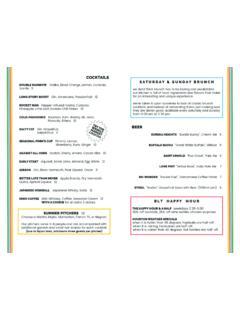Transcription of Gibson G FORCE Owner’s Manual 2.32 Gibson …
1 Gibson G FORCE owner s Manual Gibson Brands Revision 2 | P a g e Contents 03 Basic Gibson G FORCE Functions: Start Here 04 Main Tuning Preset Bank Default Tunings 05 Low Tuning Preset Bank Default Tunings 06 Re-Stringing Guitars with Gibson G FORCE 09 Changing the Gibson G FORCE Battery 09 Overview: How to Choose, Access, and Edit Advanced Functions 11 Tuning Functions ( Category) 11 String Up/Down 11 Custom Tuning 11 Custom Tuning with Pitch Assist Mode 12 Reference Tuning 12 Firmware Version 13 Battery Level 13 Temporary Global Tuning Offset 14 Reset Function (Red Category) 14 Master System Reset (Red Category) 15 Advanced Hardware Functions (Category) 15 Calibration Mode 15 Accuracy 16 Machine Head Delay 16 Machine Head Speed 16 Interference Filter 17 Advanced Software Functions ( Category) 17 Gain 17 Guitar Type 17 Pitch Window 18 Activate Low Tunings and/or Additional User Tuning Preset Banks 18 Tuning Offset Mode (Permanent or Temporary) 19 Per-String Pitch Offset (Magenta Category) 20 Block/Unblock Banks for Custom Tunings (Blue Category) 21 Capo Mode 22 Combine/Morph Tunings 23 Appendix 1.
2 What the String, BAT, and MENU LEDs Colors Indicate 24 Appendix 2: Minimum and Maximum String Frequencies for Alternate Tunings 25 Appendix 3: Custom/Alternate Tuning Tips and Shortcuts 27 Appendix 4: Charging the Gibson G FORCE Battery 28 Appendix 5: Gibson G FORCE Legal and Safety Information 3 | P a g e Basic Gibson G FORCE Functions: Start Here A) Multi-String Tuning 1. Press On button. Strum once. G FORCE tunes to the currently selected tuning. 2. When all LEDs are green, all six strings are tuned. Gibson G FORCE turns off automatically. (If any LEDs remain red, mute then pluck those strings one at a time until they turn green.) B) For a Little More Precision (Single-String Tuning Spend a Few More Seconds, Tune One String at a Time) 1. Press and hold the On button until the red E LED lights. 2. Pluck the string with the red LED. Pluck each string individually until its LED is green, and Gibson G FORCE goes automatically to the next string.
3 3. When all LEDs are green, all strings are tuned to the currently selected tuning. Gibson G FORCE turns off. C) Here s The Really Great Part!! Play In a Different Tuning 1. Press the On button two times. 2. Press Up/Down to scroll through tuning preset banks (red, green, blue) 3. Press Left/Right to get to individual tunings. 4. Press Enter briefly wait until all LEDs are red strum once (the tuners start working when you press Enter). 5. When all LEDs are green, all six strings are tuned. Gibson G FORCE turns off. 6. The new tuning is now your default. Just do either (A) or (B) to get back in tune to the new default tuning. D) Return to Standard Tuning 1. Press the On button two times. 2. Press Up/Down for the red tuning bank, then press Left/Right until the red E LED is on. Press Enter; strum once. Standard tuning is now the default (currently selected tuning). E) You can turn off Gibson G FORCE by pressing and holding the ON button Do s and Don ts Don t use string winding tools.
4 Besides, Gibson G FORCE s string up/string down function is better. Don t tune manually while Gibson G FORCE is on. Do read Appendix 5 and Appendix 6 for important safety information about Gibson G FORCE . Do recalibrate the guitar (page 15) after changing string gauge or string type. Do check the BAT LED periodically. Green = charged, = acceptable, red = time to recharge. Do charge the battery before using Gibson G FORCE for the first time. Do read the rest of the Manual to take advantage of the optional advanced Functions. Do visit for news about the Gibson G FORCE system. 4 | P a g e Main Tuning Preset Bank Default Tunings Red Main Tuning Preset bank string E A D G B e LED E standard E A D G B E A DADGAD D A D G A D D whole step D G C F A D G drop D D A D G B E B E flat Eb Ab Db Gb Bb Eb e double drop D D A D G B D Green Main Tuning Preset Bank string E A D G B e LED E open E E B E G# B E A open A E A E A C# E D open D D A D F# A D G open G D G D G B D B dobro G B D G B D e all 4ths E A D G C F Blue User Tuning Preset Bank string E A D G B e LED E A D G B e The blue user tuning preset bank defaults to standard tuning (E, A, D, G, B, e).
5 Use the chart to write in custom tuning names and tunings. 5 | P a g e Low Tuning Preset Bank Default Tunings E (Low Tuning Preset Banks) string E A D G B e LED C tuning C F A# D# G C low C C G D G A D C sharp C# F# B E G# C# B tuning B E A D F# B dropped C C G C F A D dropped B B F# B E G# C# (Low Tuning Preset Banks) string E A D G B e LED open C C G C G C E open C6 C A C G C E open B B F# B F# B D# double drop C# C# G# C# F# A# C# double drop C C G C F A C double drop B B F# B E G# B Magenta User Tuning Preset Bank string E A D G B e LED E A D G B e The magenta user tuning preset bank defaults to standard C tuning (C, F, A#, D#, G, C). Use the chart to write in custom tuning names and tunings. 6 | P a g e Re-Stringing Guitars with Gibson G FORCE For proper Gibson G FORCE operation, re-string your guitar following these instructions. To maintain a constant neck tension, Gibson recommends changing strings individually.
6 Bass Side Guitar Stringing for Gibson G FORCE 1. Unscrew the machine head cap. 2. Looking at the top of the headstock with the bass strings toward the left, the machine head s right recess should be between 4:00 and 5:00 o clock, and the left recess between 10:00 and 11:00 o clock. Low E string machine head detail. The guitar body is below the picture. 3. Thread the string through the bridge and toward the machine head. Pull on the string to take up any slack as you wrap it partially around the part of the post below the flange that faces away from the guitar body. Then, bring the string up through the flange recess that faces the tuning pegs. String winding technique. The string shaft slot (where to feed the string up toward the thread) is at an approximate 45 degree angle. The guitar body is below the picture. 7 | P a g e 4. Wind one turn clockwise around the part of the post directly above the flange. Wind the strings in the same direction (clockwise) as the direction of tightening the machine head cap.
7 5. Screw the cap on as tight as you can with your fingers, then use a penny to give an additional 1/8th turn. Do not overtighten! 6. Use String Up mode (see page 11) to tune the string. Treble Side Guitar Stringing for Gibson G FORCE 1. Remove the machine head cap. 2. Looking at the headstock from the top and with the treble strings toward the right, the machine head s right recess should be between 1:00 and 2:00 o clock, and the left recess between 7:00 and 8:00 o clock. The red line indicates a 45 degree angle. 3. Thread the string through the bridge and toward the machine head. Pull on the string to take up any slack as you wrap it partially around the part of the post below the flange that faces away from the guitar body. 4. Bring the string up through the recess in the flange, and wind clockwise around the part of the post just above the flange. 8 | P a g e String slot shaft (where to feed the string up toward the thread) with an approximate 45 degree angle.
8 5. When you wrap the string around the top part of the post, wind it directly on top of the flange, not partway up the upper part of the post. Wrap two full turns for the B and high e strings. Wind the strings in the same direction (clockwise) as the direction of tightening the machine head cap. Make sure to wrap two full turns with the B and high e string before tightening the cap. 6. After wrapping the string around the top part of the post, pull it tight with one hand as you screw on the cap with the other hand. 7. Screw the cap on as tight as you can with your fingers, then use a penny to give an additional 1/8th turn. Do not overtighten! 8. Use String Up mode (see page 11) to tune the string. 9 | P a g e Changing the Gibson G FORCE Battery A fully-charged battery provides approximately 100 tunings more if you re just touching up. Please read Appendix 5 (page 27) for information about proper battery care and charging.
9 To remove the battery: The battery compartment is located in the Gibson G FORCE controller on the back of the headstock. Push down on the rectangle that s visible at the top of the controller (between the machine heads for the 3rd and 4th strings). The battery will pop up slightly. Note the groove facing outward at the top of the battery, and use it to pull the battery out of its compartment. To insert the battery: Never FORCE the battery into its compartment. If it does not insert easily, it is not being inserted correctly. Insert the battery with its two metal contacts facing outward and away from the headstock, and the pins pointing downward into the compartment. Push downward gently on the top of the battery until you hear/feel a click. If the top of the battery is flush with the top of the controller, it s seated correctly. Overview: How to Choose, Access, and Edit Advanced Functions Gibson G FORCE is easy to use. The most common functions tuning a guitar to standard and alternate tunings take a few button presses.
10 The string LEDs (from E for the 6th, lowest-pitched string to e for the 1st, highest-pitched string) show the system status. Gibson G FORCE stores standard, alternate, and custom tunings in presets. Each preset contains a tuning. This can be a factory default tuning, or a custom tuning you create and store. Follow the simple instructions in the Quick Start guide, and your guitar will always be in tune. 10 | P a g e However, Gibson G FORCE is like a video game with additional levels. These levels offer advanced tuning functions. Use them or not; it s your choice. Here s an overview of how to choose, access, and edit the advanced functions. Categories. Gibson G FORCE has six main Categories. After pressing the On button three times (don t press too fast each one should be about a second apart), press the Left/Right buttons to select a Category, and then press Enter. Each Category has an associated color. Examples: The Category is mostly advanced software functions.






![WELCOME [www.royalboucherie.com]](/cache/preview/2/9/0/5/d/1/3/0/thumb-2905d1307532ea1c35ae2166a21856f7.jpg)
